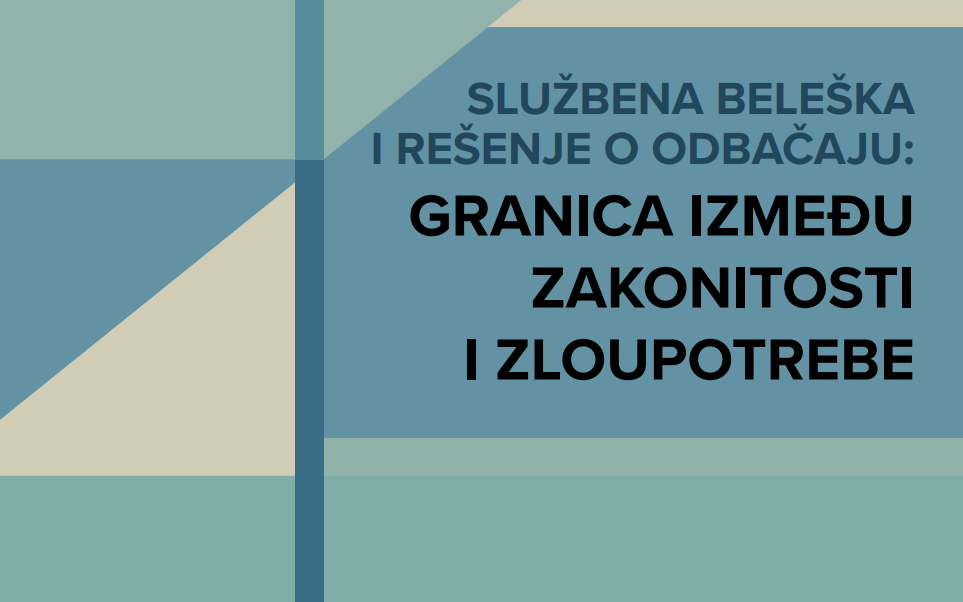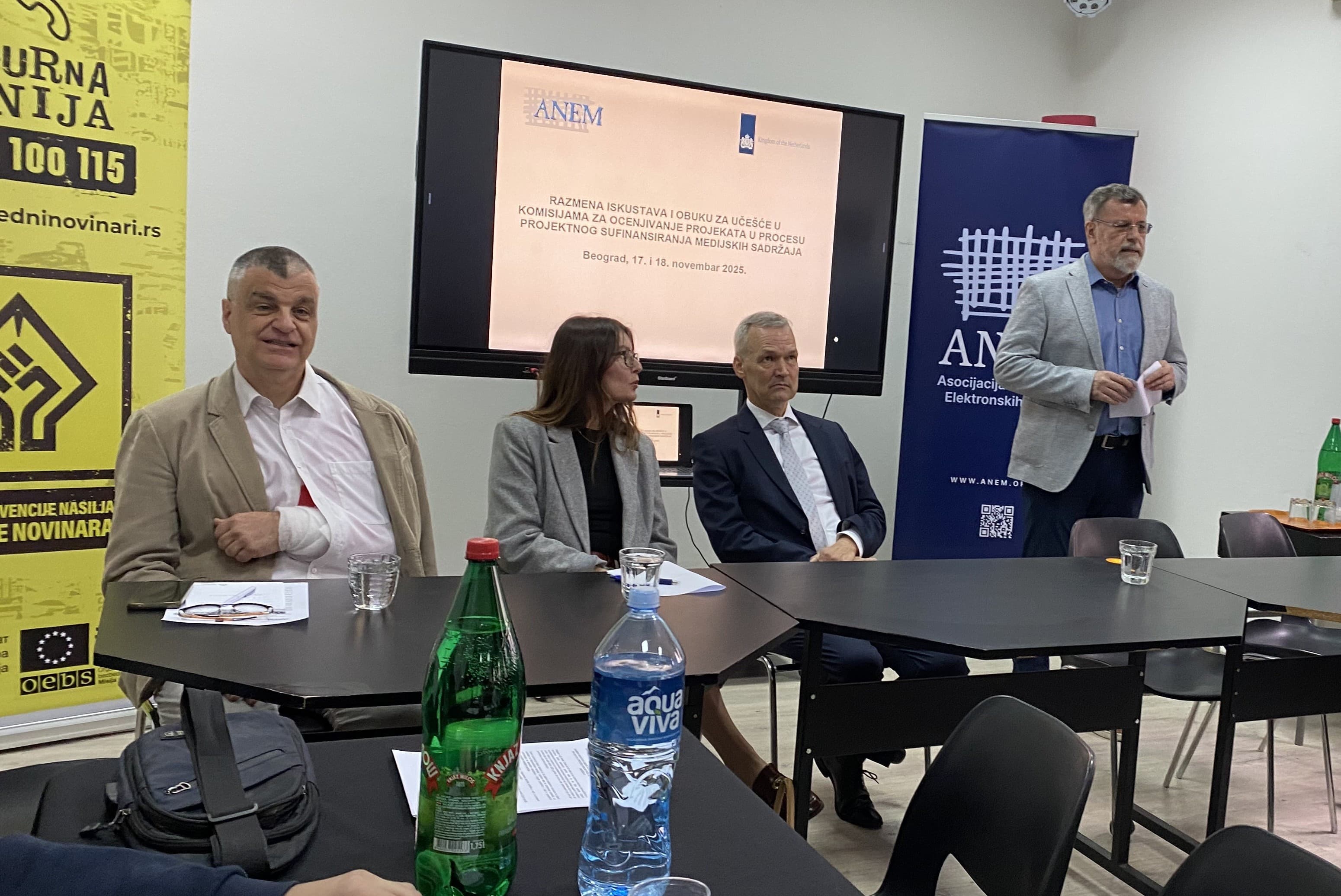Slaps, bruises, and fractures: Police violence during protests
During the protests and blockades across Serbia in late June and early July, numerous cases of excessive use of force by the police were reported. Among the injured are students, doctors, and photojournalists who claim they were attacked by police officers, often wearing masks. While the Ministry of Interior remains silent, citizens are speaking to CINS about what happened.

Camera, press accreditation, and vest.
In this way, Aleksa Stanković, a 22-year-old history student, typically identifies himself at protests and blockades where he is photographing, to clearly indicate that he is reporting as a photojournalist from such events.
He also carries a small camera, which he turned on during one of the blockades, on July 2, shortly after midnight.
He was standing at the corner of Roosevelt Street and Queen Maria Street when he saw three police officers in uniform, wearing masks and helmets, approaching him.
“I decided to take a step back so that we wouldn’t collide and there wouldn’t be that kind of problem. Then I saw one of them directly rushing toward me. He stepped on my right leg with his left foot and asked for my name,” Aleksa says in an interview with the Center for Investigative Journalism of Serbia (CINS).
After introducing himself and stating that he is from the media, he says their reaction suggested they knew who he was and what he was doing.
“He turned to his colleagues, repeated my name, and told me to come with him.”
They then ordered him to turn off the camera, and the recording ends. Afterwards, Aleksa says he got into a police van, also known as a paddy wagon.
According to him, the officers threatened and slapped him, stating that he had created a huge problem for them with the video recording. This recording was made a few days earlier, showing police officers making derogatory comments to a girl passing by them.
He claims he was slapped alternately by two police officers.
They broke the memory card from the camera and then demanded that he delete his Instagram profile.
“When I replied that I didn't know how to do that, he started to lose it and went into some kind of hysteria. He grabbed my head and hit it against the vehicle's window multiple times. With his right hand, he struck the right side of my head. I counted up to 10 hits, give or take,” Aleksa recounts.
The Ministry of Internal Affairs (MUP) did not respond to CINS's inquiry about whether they are aware of this incident, whether the police officers allegedly involved in the incident have been identified, and whether any disciplinary or criminal proceedings have been initiated against any police officer in this regard.
CINS has recorded over 30 instances of police use of excessive force since the Vidovdan protest on June 28 and the subsequent blockades. Most of the incidents we recorded were filmed.
The Internal Control Sector of the MUP did not respond to CINS's inquiries about whether any actions have been initiated regarding the misuse of authority by police officers since the Vidovdan protest in Belgrade.
Sanja Radivojević from the Belgrade Center for Human Rights (BCLJP) states that they have filed 15 criminal complaints so far, but adds that there will be more as people continue to seek their assistance.
She mentions that all the citizens who contacted them were beaten by police officers whose identities are unknown, and who were in full riot gear, without insignia and wearing masks.
“Just because they were in the wrong place at the wrong time, when either a line of police was passing by or when a large number of citizens were gathered there,” Radivojević states.
Beatings and Consequences
Aleksa Stanković photographed the violent arrest of anesthesiologist Vladimir Stefanović.
The photographs show Vladimir on the ground, taken down by members of the gendarmerie.
Vladimir states that at one point he saw police officers beating someone, and he shouted something like, “You’re hitting children, don’t hit them.”
At that moment, according to him, the police began to hit him in the shoulder, forearm, and shoulder blades, and then he was arrested.
The decision from the Higher Court in Belgrade, which ordered Vladimir's detention, which CINS had access to, states that he hit police officers' shields and protective helmets with a wooden stick. However, Vladimir says he stood with his hands raised and did not have a stick.
“Did I deserve to be beaten? No, because I didn’t attack anyone. I didn’t hit anyone. I didn’t plan to hit anyone,” Vladimir states.
He spent nine days in detention before being released.
On the same evening as Vladimir, student Luka Mihajlović from the Faculty of Technical Sciences in Novi Sad was also arrested.
As his lawyer Božo Prelević told CINS, Luka was near the Church of St. Mark in Belgrade, about 50 meters from the police cordon. His arrest was recorded on video.
“It seems to me that he didn’t understand that he was a threat to anyone, so he raised his hands. He didn’t even run away, and then he received a terrible blow, one or two, it’s not very clear. Then he started to walk towards the police, clearly not understanding that he should run away from them. In the end, you can see how they take him down to the asphalt, tie him up, and then lead him away bleeding,” Prelević explains.
He explains that Luka was hit by a person in uniform, resulting in fractures of three facial bones – nasal, sinus, and zygomatic bones.
The court ordered his detention, but he spent days in the Clinical Hospital Center Zemun, until July 9, when he was first placed in the detention unit of the District Prison in Belgrade. He was transferred to house arrest on the same day.
However, police violence was also recorded after the Vidovdan protest, during traffic blockades.
Student and activist Nikolina Sinđelić was at a blockade of the roundabout at the entrance to Obrenovac on July 2. When incidents occurred after midnight, she took her phone to record them.
At that moment, an inspector approached her from behind, Nikolina recounts.
“He just pulled me, hit me in the jaw, hit me in the chest, and my head turned. I didn’t see at all what happened. I was completely confused.”
She was not arrested, but later went to a doctor for an examination. Her chest was bruised, and her jaw and head were painful.
From the Basic Public Prosecutor's Office in Obrenovac, CINS was informed that they have initiated a preliminary investigation regarding this case.
Circle of Impunity
Sanja Radivojević from the Belgrade Center for Human Rights says that such cases often remain unresolved.
The inaction of institutions, prosecutors, and the Emergency Control Sector of the MUP, above all, leads to the expiration of cases, and thus to the inability to establish criminal responsibility for those who commit violence, claims Radivojević.
She adds that the slow process can also lead to a lack of evidence. If the prosecutor does not issue an order to the police to secure material evidence within a certain timeframe, audio and video recordings from police stations may not be available.
“You know that these audio and video recordings are kept within the stations for about 30 days, sometimes even less. This means that if the prosecutor does nothing within 30 days of filing a complaint, those at the station can say, ‘Well, you should have come earlier, we only keep audio and video recordings for 30 days.’”
Additionally, Radivojević points out that other police officers who witnessed the act of violence do not want to testify against their colleagues.
“When they all draft reports on the use of coercive measures, those reports are identical, as if someone copied the same report. Sometimes it even happens that the punctuation marks match. These are completely standardized reports on the use of coercive measures to the detail,” Radivojević states.
She adds that establishing criminal responsibility for police officers is the exception, but if it does happen, they generally receive a suspended sentence of six months.
“Why? Because with such a sentence they do not lose their job under the Law on Police. So only if they were given a higher sentence would they be dismissed.”
She says this is called a circle of impunity in which all perpetrators contribute to ensuring that no one is held accountable for the violence committed.
Source: CINS
Related Articles

Saša Mirković on the election for the REM Council: We are in a kind of vacuum; there is political instrumentalization of the process.

"I am not sure what to expect when I go out on the street": Journalist Isidora Kovačević after the court acquitted the man who was posting wanted notices with her image.











